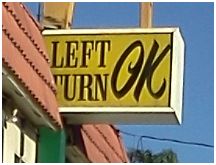Just as the Himalayas are adjoined by the plains of Northern India, so does the Hillside Dingbat District of Palms have the advantage of neighboring flatlands to set it off. We have already examined a few of the architectural gems belonging to the area on a one-off basis, and now we look at a few more distinctive residences.
Now and Zen
The allusions to India and the Himalayas are admittedly a stretch, but we were more surprised than anyone to happen on this unusual shrine in front of what otherwise is an ordinary dingbat complex.
As it happens, the Buddha here is actually a fountain whose waters drip gently from the spout at the top to a basin below, producing a satisfying contrast with the dry landscaping that surrounds it.
Hedges
When observing the dingbat in its natural habitat, it seems that the standard front garden consists of a four-foot-wide strip of grass and possibly flower beds all along the front of the property. (In spite of this limited square footage, it still requires forty-five minutes of horticultural fine-tuning once or twice a week, said fine-tuning to be administered with various types of extremely noisy implements.)
We therefore tend to notice the dingbat whose builders or owners have gone an extra mile or two in the area of greenery, because they sometimes achieve a kind of modernistic grandeur which is usually not seen in the average detached house. One big reason for that is the fact that, for most of the 20th Century average houses in this region have almost always been single-story. You usually can't grow an imposing ten-foot hedge in front of a ranch house.
 |
| Hedged Dingbat |
But you can certainly do it in front of your two-story dingbat. This particular specimen displays several features apparently calculated to elevate its class appeal. Beginning with the second story, the tall narrow windows on either side of the corner, posts, and textured wall all suggest an upscale house, or possibly a small mid-century office building such as you might find in Beverly Hills along Wilshire. The tall hedge conveys an above average expectation of privacy.
And that feeling of privacy is enhanced by this curving walk, which is truly unusual in the dingbat domain. We are reminded of Paul Fussell's observation* of upper class houses and the curved driveways that lead to them.
The word "cove" does inspire us to seek out additional allusions to nautical life, or even pirates -- but this quest turns out to be in vain.
* Paul Fussell, 1983. Class. A Guide Through The American Status System. New York: Ballantine, 1983. p80
Tombstones
A curious trend in apartment houses has sprung up: stuccoed obelisks that rise up in front of them, presumably intended to attract renters by announcing the amenities of the place.
That seems straightforward enough, yet shown here is the only specimen we know of that actually puts the sign to use. In all the rest, they are completely unadorned with anything that would give them a purpose. They stand starkly like tombstones that still await the engraver's chisel.
The word "cove" does inspire us to seek out additional allusions to nautical life, or even pirates -- but this quest turns out to be in vain.
* Paul Fussell, 1983. Class. A Guide Through The American Status System. New York: Ballantine, 1983. p80
Tombstones
A curious trend in apartment houses has sprung up: stuccoed obelisks that rise up in front of them, presumably intended to attract renters by announcing the amenities of the place.
That seems straightforward enough, yet shown here is the only specimen we know of that actually puts the sign to use. In all the rest, they are completely unadorned with anything that would give them a purpose. They stand starkly like tombstones that still await the engraver's chisel.
Or like mysterious alien obelisks that still await the enquiring touch of some passing prehistoric hominid.
We can almost hear the music from 2001: A Space Odyssey.














